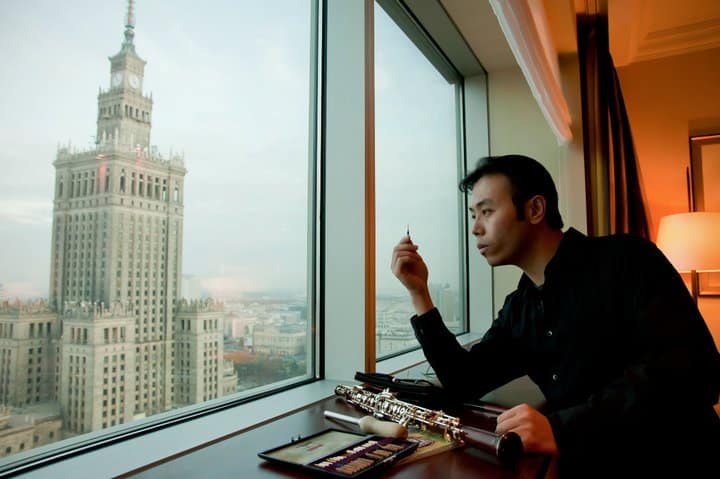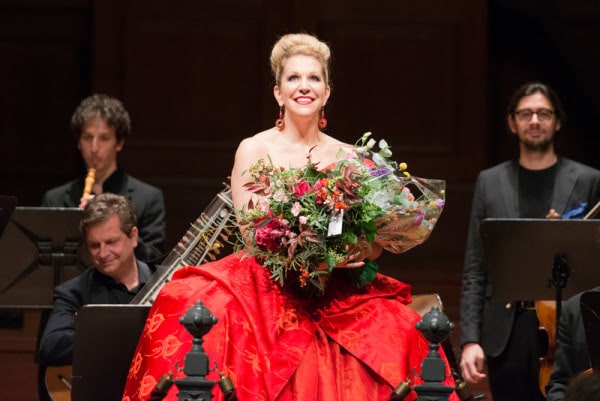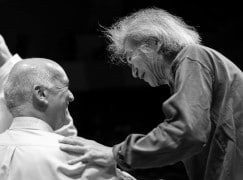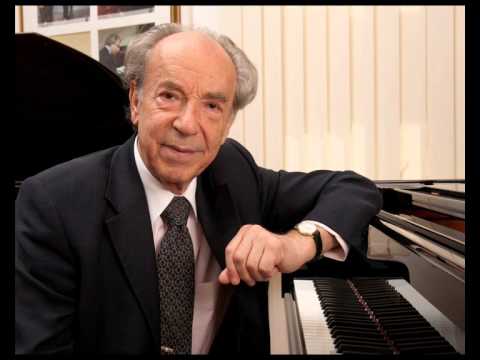For sale: The portrait Mahler signed for Schoenberg
mainA hard-up veterinary student is selling on ebay a portrait that Gustav Mahler inscribed to Arnold Schoenberg in Vienna in 1907. The provenance is complicated. It appears the portrait belonged to the student’s grandfather, Abraham Fraser, who obtained it from his teacher, Joseph Schmid, a friend of Schoenberg’s.
See the full story here.

The price? A mere $150,000.





Dubious provenance, likely not returned to the Schoenberg family after an exhibition as USC in the 1950’s. The price he is seeking is ridiculous and he has been relegated to E-Bay as the major auction houses will not touch this piece without an unimpeachable provenance.
A worrying provenance indeed. There’s much more from a few years ago (2012) on the history of this photo. See: http://schoenblog.com/?p=184
The suggested website for historical information is invalid. It was written by Randy Schoenberg. Definitely a conflict of interest.
Hey, I got my DB9 on e-bay, too…
Stolen. See http://schoenblog.com/?p=184 and http://schoenblog.com/?p=288
What’s the lawyer doing?
If you had any evidence that this item was stolen then why did you offer money for it just a few weeks ago.
It is clear to me that the photograph was taken from our father’s legacy. My father did not give it away, my father did not sell it, my mother did not give it away and she did not sell it. We, his children did not give it away nor did we sell it. My sister, Nuria Nono remembers it well in our father’s study and discovered that there were only empty frames at the Schoenberg Institute at USC. She disclosed this to the archivist and later again to the archivist at the Schoenberg Center in Vienna.
If someone had purchased it or received it as a gift would they not display it prominently rather than stuffing into a drawer?
Anyone interested can gather more information by reading Randy’s blog:
http://schoenblog.com/?m=201210
I understand how important this picture has become to you. What I am having trouble understanding is why you had never seen or heard of it before 2012. Why didnt you sister not inform you of its existence and its alleged disappearance prior to this time? Furthermore, the archivist at USC has no recollection of your sister looking for the inscribed picture as you claim.
Correction: why didn’t your sister inform you
In fact what is important to me is to discover who and when someone took items from my father’s legacy. He was very careful to retain everything in order. After he died in 1951, my mother did the same. We, his three children, donated his archives to USC when they established the Arnold Schoenberg Institute in 1974. We later transferred the entire contents of his legacy to Vienna when USC, in effect, evicted us –the USC administration publicly stating that “we were not getting enough bang for the buck”. What is important to me is to find out who took some Moses and Aron sketches, who took two Schoenberg drawings that were being exhibited at the USC Fisher Gallery (incidentally they were removed from their frames just as the Mahler photograph had been), who took the Kokoschka crayon drawing that was hanging in our house among other items.
What makes you think that I had never seen or heard of the Mahler photograph before 2012? My sister did, in fact, see the photograph in our home in Los Angeles. She did, in fact mention that it was missing to the archivist at USC. There are others that could have seen it in my father’s study including Robert Craft, Richard Hoffmann, Norman Lloyd, David Raksin, Josef Rufer, Leonard Stein, Jan Maagard, Mitzi Kolisch … unfortunately, many of them are deceased and others, like your grandmother, are elderly with fragile memories.
I am not sure what is the relevance your statement: the archivist at USC has no recollection of your sister looking for the inscribed picture. Are you talking about Clara Steuermann, Jerry McBride or Wayne Shoaf? They all were archivists at the Institute. If one of them said to you that they did not recall that my sister inquired about the photograph, that would only mean that they did not recall a conversation. That would not be entirely surprising since obviously, they had not seen the photograph – they had only seen the empty frame.
I will post a chronology that will illustrate why your version of how the photograph’s journey from our home in Los Angeles to your grandfather’s house “buried in the back of the boiler room” in is not possible.
So, after going back and forth for over two years, you, Larry Schoenberg, now remember the picture. In one of our fist conversations, you stated “ I am not aware of the picture.” You may want to read our original emails. You mention a bunch of items allegedly stolen from USC. The Mahler picture wasn’t on the 1974 Sonja Lane inventory, it never made it to USC. Also, you ask which archivist has discredited your sister’s story. The only archivist Nuria specifically claims to have spoken to about the photo’s disappearance. Read your nephews blog.
I will save you the trouble of constructing a chronological time line. Using only documented evidence, and excluding your sister Nuria’s claim, leaves only one logical conclusion; Mahler gives the picture to Schoenberg in 1907, Schoenberg gives the document to Schmid in Berlin between 1912 and 1915, Schmid brings the picture to Brooklyn in 1936, Schmid gives the picture to my grandfather in 1958 who brings it to California, I discover it in 2012.
Lastly, you have named a number of people that you claim may now remember the picture. You have had over two years to mention these sources but instead you waited for today. Although, Im sure if they are friends of yours they would be more than willing to support your claim.
It would be more honest if the person writing these messages (and the ebay listing) on behalf of Cliff would disclose his/her identity. But apparently honesty is not what this is about for Cliff and his colleagues.
There’s also an article in The New York Times about it:
http://www.nytimes.com/2012/10/11/arts/music/a-clue-to-whereabouts-of-schoenbergs-missing-mahler-photo.html?_r=0
Cliff Fraser writes on Ebay: “One may speculate the transfer of the portrait to either be a gesture of gratitude or a trade for a debt.”
Even if Schoenberg and Joseph Schmid were pretty close at one point in their lives, to me it seems highly unlikely that Schoenberg would do either things; after all, it was one of most precious possessions.
This photograph was last seen in 1913. How do you know how important this was to Schoenberg? Where are you getting this information?
I stumbled upon this item on Ebay and found myself curious. After some research, I found that many of the things stated in the presentation are true. This makes me want to ask this question: knowing that Arnold Schoenberg found himself several times in financial debt, would it have not made sense for him to sell the photograph to fix his financial issues? Granted, one could argue that to Schoenberg the photograph was too valuable. Either way, there is no evidence portraying the level of attachment this composer had to the photo, making the statement from the seller you quoted still valid.
Key figure here is Nuria Schoenberg Nono, who rembered the photo hanging in Schoenberg’s study in Los Angeles. She said the photo was missing between 1987-1991 and reported this to two archivists. Now why would she or E. Randol Schoenberg lie about that? His blog is very well documented and I tend to believe his side of the story more than Cliff Fraser’s, whose only interest, after all, is to get as much money as possible for the historical photograph.
Schoenberg worshipped Mahler, he “spoke of Mahler as a saint”, this is also very well documented. To me it’s pretty obvious that he would have never sold the picture as it had too much value — one that could not be expressed in terms of money. Also, it’s not very likely that he would have given it to anyone as a present.
Not sure what is the big deal. I’ve got lots of photos of Mahler. You can have some too, just open Google and type his name. The only photos of the man that really count are the ones on the jackets of his recordings. All the rest are mere sentimental ephemera.
I would like to make some clarifications regarding this coveted item. Firstly though, I would like to extend my sincere appreciation for the interest that so many of you have shown towards this photograph. After all, it is an exquisite historical token. Nevertheless, an important issue needs to be clarified regarding the acquisition of this artifact. As inferred in the description posted for this inscribed photograph, the seller, Clifford Fraser, inherited this item from his grandmother. One may speculate the item may have been stolen at a time previous to this event, but many hours of research and various sources of evidence demonstrate the legitimacy of the acquirement.
First and foremost, there have been no reports about the item being stolen or missing by either law enforcement institutions, museums, or random interested parties. With such evidence, one can logically discredit the implications of theft. Additionally, the seller would doubtfully be able to place such item on auction, especially on a world renown auction house such as ebay, if the legitimacy of the item was under question. As for the claims of previous knowledge of the inscribed photograph made by Arnold Schoenberg’s heirs, these were debunked by the archivist of the Schoenberg Legacy at USC. Furthermore, a different article posted by the New York Times strongly supported the legitimacy of this photograph’s acquirement, also demonstrating the level of desire or interest the Schoenberg heirs had, or possibly still have, for this item. Knowing that Mahler’s inscribed portrait was inherited to Mr. Fraser in 2012, one should seek the answer to why the Schoenberg heirs never reported such portrait missing from their possession prior to this date. As well, evidence of interest by the Schoenberg heirs towards this incredibly valuable historical photograph began emerging only after Fraser’s acquisition of the portrait, further leaving theft claims unsubstantial. http://www.nytimes.com/2012/10/18/arts/music/man-with-mahler-photo-complains-of-pressure-from-schoenbergs.html?_r=0
Much time and money have been invested into research prior to coming to the decision to sell this photograph. The main intention of this post is to bring to light some evidence about the authenticity and ownership legitimacy of this magnificent item.
Who are you? What is your relation to Cliff?
You say “Clifford Fraser, inherited this item from his grandmother.” Did she die? Was there a will? Last time he was trying to sell the item, it appeared he had pilfered it from his grandmother after finding it buried in a closet at her home. Cliff’s own father was very dubious about his son Cliff and his claims about the photograph.
Since Cliff previously has not been able to spell or write without numerous errors, I suspect someone else is behind the ebay listing. Is it you? You realize that aiding and abetting the sale of stolen property is also a crime, right?
I’ll disregard your insults, you’re obviously upset.
Mr. Randy Schoenberg,
I am going to start this message by clarifying that I have no personal issue with anyone following this post. As of fact, I do not find any interest in initiating any tension between people in this forum, but meerly explaining facts and evidence that not only have been presented to me, but that I also researched for pure cultural growth purposes.
As for who I am, my name is Cesare Giacopetti and I have been a close friend to Clifford for some time now. Regardless of my relationship with Clifford, I would like to think myself as an individual who tries to his best to view life through logic and evidence, what many others would otherwise call deductive reasoning. When the issue fell upon my attention, I decided to keep an open mind and analyze as many aspects as I could related to this controversial topic we are all here discussing.
What I presented in this forum is a collection of observations and facts that can lead one to speculate Clifford’s acquisition of the portrait, and in all honesty it does not appear to me that any illegal activities were undertaken by anyone with the intent of obtaining this valuable object.
As well, I would like to clarify that I have not attempted, nor will I ever try, to offend you or your family. I was taught to show anyone the outmost respect, regardless of how I am being treated. Additionally, anything that I may have wrote was not meant to imply that your side of the story was untrue, inaccurate or unfounded. However, I do believe that between the different parties there are conflicting recollections.
From what I can tell, nonetheless, I can see that all Clifford has done is show evidence and facts to those who are interested. And not to sound critical, but most of the posts on this forum have shown no evidence to the claims that some people have made towards either Clifford or the ownership of the photograph.
If anyone would like to challenge what I have posted, I welcome it and I appreciate it. After all, it is important to be objective in situations like these and be able to examine all possible information one is presented. In conclusion, if you would like to make any corrections about what I wrote, please do so with relevant evidence regarding the topic, and not by questioning my persona. Frankly, that is insulting.
Best regards,
Cesare Giacopetti
Cesare, the facts, in case they really are a concern, are all set forth in great detail on my blog posts at http://schoenblog.com/?p=288 and http://schoenblog.com/?p=184 You and Cliff have ZERO evidence for how the photo came to be buried in the boiler room of Cliff’s grandmother’s home, and Cliff has been less than forthcoming since this whole episode began. We are grateful that the photo has been found, but it really needs to be returned.
I believe it is important for the public to be able to examine the claims made by the Schoenbergs and the events that they say prove the photograph’s theft.
Nuria remembers seeing the photograph in her father’s Brentwood study in the early 1950’s, prior to her prompt move to Europe. Her brother Larry, who has no memory of the picture, resides in their father’s home where he still lives to this day. At some point, the Schoenbergs suggest that their mother lends the picture to some unknown exhibition and makes no record of it. In 1974 Sonja Lane makes an inventory list of the Schoenberg collection which does not include the photograph. Despite this, in the late 1980’s Nuria returns to California in search for the picture in the USC archives. Unable to find it, she informs the Archivist in charge, who has no recollection of the conversation. Furthermore, Nuria does not request a police report or leaves any form of writing documentation about the events, nor the whereabouts of the photograph. Next, instead of going to her brother Larry, who still lives in the home where she remembers last seeing it, she keeps the information to her self for 25 years and ultimately tells her story after my discovery.
Regarding Nuria’s claim to have seen the photograph in her father’s Brentwood study, there is conflicting evidence. On the Arnold Schoenberg Center website there are over a Thousand photographs of the Brentwood home. Fifteen of these photographs are of Schoenberg’s study. The Mahler photograph is no where to be found. The Schoenbergs’ claim that the item in question was one of their father’s prized possessions, although it has managed to evade the camera and people’s memory.
The Schoenbergs’ claim that their mother would never sell nor give away the photograph, but also state that she lent it to some unknown party without documenting ownership, purpose of use, or time it should be returned. Is this not what someone does when giving something away? Regardless, there would be a record of the photograph if it where displayed at an exhibition or a museum. An item of such importance would have been showcased. The item, however, is neither mentioned nor appears in any magazine, article, or journal.
Lastly, Nuria claims to have noticed the photograph missing when searching the archives at USC. Despite that fact that the archivist has no memory of this claim, is it not reasonable to think Nuria would ask her brother Larry about the picture’s whereabouts? Larry was still living in their father’s Brentwood home, the location Nuria remembers last seeing it, which is right down the street from USC.
I would also like to add that Larry Schoenberg lists a number of items that have disappeared from the Schoenberg collection. These items are well documented as being in Schoenberg’s possession, their disappearance is documented, and are nowhere near as significant as the item in question.
Cliff, or whoever is writing these messages for Cliff, you make a number of errors. First, Larry has not lived in the Schoenberg home since about 1971, when my father Ronald and our family moved in. We do not know whether my grandmother may have loaned the item out or not. That is one possible explanation. She became ill with cancer and died rather quickly in early 1967. Some other items that she had let people borrow were not returned, which makes this also a possibility for the Mahler photograph. As just one example, which I sent you last month when I offered to try to resolve this issue, recently some photographs and sketches related to Gurrelieder which had been loaned to the Edinburgh festival in 1961 were returned to the Schoenberg Center in Vienna. As we have said repeatedly, there is zero chance that my grandfather, grandmother, or anyone else in the family would have sold this photograph. It must have been stolen. You also have no idea where your grandparents got it, or how it ended up in their home where you found (and apparently pilfered it). Let’s remind everyone again how you first described it in 2012: “my Grandfather died in 1987 and I just found the picture berried [sic] in back of the boiler room of his house (I could hardly see through the frame; I almost threw it away).”
First, I will start by changing my previous statement regarding your uncle’s residence. Larry lived in his father’s home for an additional twenty years after his father’s death, yet had unlimited access thereafter, and still had never seen the photograph.
Your claim that I have no idea how this photograph came to be in my possession is false. I have my grandfather’s close relationship with composer Joseph Schmid, who had a direct line to Schoenberg. In fact, he is a direct line to the photograph’s last known provable location. I have my grandmother’s statement of how my grandfather acquired the photograph. And lastly, I have the photograph in my possession.
You state that I have no idea how the photograph ended up in my grandfather’s boiler room, however I do. After my grandfather’s death, his possessions where stored away, a portion of which ended up in the boiler room. What you are suggesting is that my grandfather was hiding it there and knew that it was a valuable stolen object. If this where true, then why would he place such a fragile photograph next to a boiler? Why not in a drawer like your uncle Larry suggests? Clearly, no one was looking for it.
I will close this by addressing your comments about my spelling errors and how this cannot be Clifford Fraser making these posts. I mean this sincerely, coming from a distinguished gentleman such as yourself, I take this as a huge compliment. You can see I have been working hard.
This discussion has run its course. Sort it out in court.